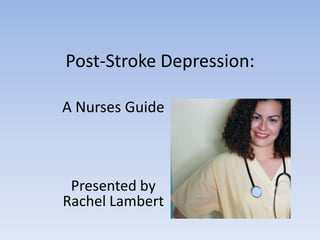
Post stroke depression
- 1. Post-Stroke Depression: A Nurses Guide Presented by Rachel Lambert
- 2. Objectives RN will understand the prevalence, roadblocks and importance of identifying PSD RN will be able to identify the risk factors and signs and symptoms of PSD RN will be familiar with the assessment tools used in identifying PSD RN will be familiar with treatments to combat PSD
- 3. Who does PSD affect? 1 out of every 3 post-stroke patients Largely under-reported If not treated PSD can affect Rehabilitation Recovery Quality of Life Caregiver health Survival Health Care System
- 4. Effect of PSD on Recovery Depression may jeopardize a patient’s ability to meet functional goals and to reintegrate into society The incidence of complications (e.g., skin breakdown, urinary tract infections), hospital length of stay, and medical costs expenses may all increase because of depression. PSD has been linked with higher mortality rate
- 5. Risk Factors for Post Stroke Depression Female gender Age 60 or younger Divorced Alcoholism Non-fluent aphasia Having a major motor or cognitive deficit Nursing- home/Rehab placement Lack of Social Support
- 6. Types of Post-Stroke Depression Major Depressive Disorder Dysthymic Reactive Depression
- 7. Diagnostic Criteria for Major Depressive Disorder At least one cardinal symptom : low mood or diminished interest in almost all activities plus three or four cluster symptoms for a minimum total of five symptoms. Both the cluster and cardinal symptoms should be present for at least 2 weeks and denote a change from a previous functioning condition.
- 8. Major Depression Incidence and Recovery Etiology Effect on Brain Function Suicidal Ideation
- 9. Dysthymic Depression Prevalence Duration of two years Response to treatment Antidepressants Risk of double depression
- 10. Sign and Symptoms of PSD Significant lack of energy Lack of motivation Problems concentrating Difficulty finding enjoyment in anything Sleep disturbances
- 11. Why does PSD often go undiagnosed? Diagnosis of PSD is challenging in the acute and chronic aftermath of stroke Stroke symptoms can mask depression symptoms making it hard to distinguish the root of the impairments a patient is experiencing
- 15. Onset of PSD Occurs in all phases of stroke recovery Peak incidence and severity of depression occur between 6 months and 2 years after stroke
- 16. Apathy vs. Depression Apathy is a motivational disorder that can occur in the presence or absence of depression Apathy associated with attention and processing Speed deficits Depression associated with memory and executive function issues By understanding the differences, the proper intervention can be determined
- 17. Crying Behaviors Identifying distinctions among crying behaviors is an important aspect of assessing post-stroke RN must be able to distinguish crying that's congruent with a mood of sadness from other crying behaviors Pathologic crying , Emotionalism, Catastrophic Reactions
- 18. Treatment Treatments that have been proven to be effective include: Antidepressant medications Behavioral therapy Alternative therapy
- 20. Zoloft
- 22. Novel Antidepressants Dosage/Side Effects/Drug Interactions Wellbutrin Effexor Remeron
- 23. MAOI Inhibitors Monoamine oxidase inhibitors (MAOIs) Dosage/Side Effects/Drug Interactions Nardil Marplan Parnate
- 24. Behavioral Therapy Cognitive therapy thoughts lead to moods Problem-solving therapy mental health professionals meet with stroke survivors to facilitate awareness of problems and help develop solutions Psychosocial behavioral intervention stroke survivors are provided with opportunities to interact with educational materials and interventionists
- 25. Alternative Therapy Utilizing pre-existing coping techniques Repetitive Transcranial Magnetic Stimulation Music Therapy Acupuncture
- 26. RN’s Role A multidisciplinary health team is essential in PSD screening, diagnosis, treatment, monitoring and prevention of potential complications. RN plays an important role in Identifying risk factors Effectively Screening Patients Educating patients and their families on treatment options to combat PSD
- 27. Nursing Considerations A post-stroke patient may need spiritual support, counseling with a provider who has experience with the diagnoses, and support groups Providing resources including printed materials, websites, and organizations is helpful for the patient and family members Assess the patient’s and family’s perception of the diagnoses, and coping mechanisms
- 28. Nursing Considerations If the patient is intubated and unable to speak, identify alternative methods of communication Review prescribed medications (antidepressants) with patient and /or family members e.g. side effects and dosages Encourage patient and family to prioritize needs and learn to accept help
- 29. Desired outcome An empowered patient able to participate in their recovery process!
- 30. References Brodaty, H Sachdev, P Withall A, Altendorf, A Valenzuela , MJ Lorentz, L. “Frequency and clinical, neuropsychological and neuroimaging correlates of apathy following stroke - the Sydney Stroke Study.” Psychol. Med. 35(12), 1707-1716 (2005). “Depression Trumps Recovery “-Excerpted and adapted from "Depression Trumps Recovery," appearing in Stroke Connection Magazine September/October 2003. (Science update May2008) http://www.strokeassociation.org/STROKEORG/LifeAfterStroke/RegainingIndependence/EmotionalBehavioralChallenges/Depression-Trumps-Recovery_UCM_309731_Article.jsp Fralick-Ball, Susan. “Post-stroke depression: early assessment and interventions can promote optimal recovery.” ADVANCE Newsmagazineshttp://occupational-therapy.advanceweb.com/features/articles/post-stroke-depression.aspx?CP=2 Gaete, J and Bogousslavsky, J. "Post-stroke depression." Expert Review of Neurotherapeutics 8.1 2008 Jan: 75-92. Academic OneFile. Web. 15 Jan. 2011. Hackett, M. L., et. al. “Management of Depression after Stroke; A Systematic Review of Pharmacologic Therapies.“ Stroke; 2005 May;36:1092-1097. Lökk, Johan Delbari, A . “Management of depression in elderly stroke patients .“ Neuropsychiatric Disease and Treatment 2010:6 539–549 http://www.ncbi.nlm.nih.gov/pmc/articles/PMC2938303/pdf/ndt-6-539.pdf Melrose, Sheley PhD, RN. ”How to uncover post-stroke depression.” Nursing Made Incredibly Easy! 2010 July/Aug; 8 (4):31 - 37. Mitchell ,PH Veith, RC Becker, KJ Buzaitis, A Cain, KC Fruin,M et al. “Brief psychosocial-behavioral intervention with antidepressant reduces poststroke depression significantly more than usual care with antidepressant: living well with stroke: randomized, controlled trial.” Stroke 2009;40:3073-8. Paolucci, Stefano. “Epidemiology and treatment of post-stroke depression.” Neuropsychiatric Disease Treatment. 2008 February; 4(1): 145–154. Published online 2008 February. PMCID: PMC2515899 Stradling, Dana RN, BSN, CNRN. September 25, 2009 .“Stroke and depression: continuing education course for the RN.”Published online 2009 September . http://dynamicnursingeducation.com/class.php?class_id=129
